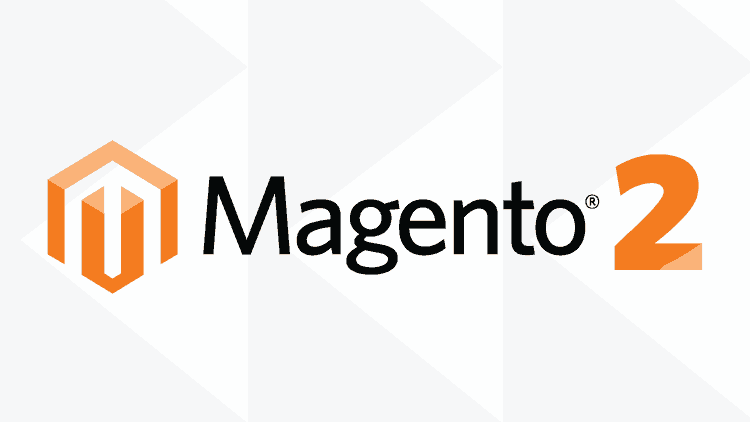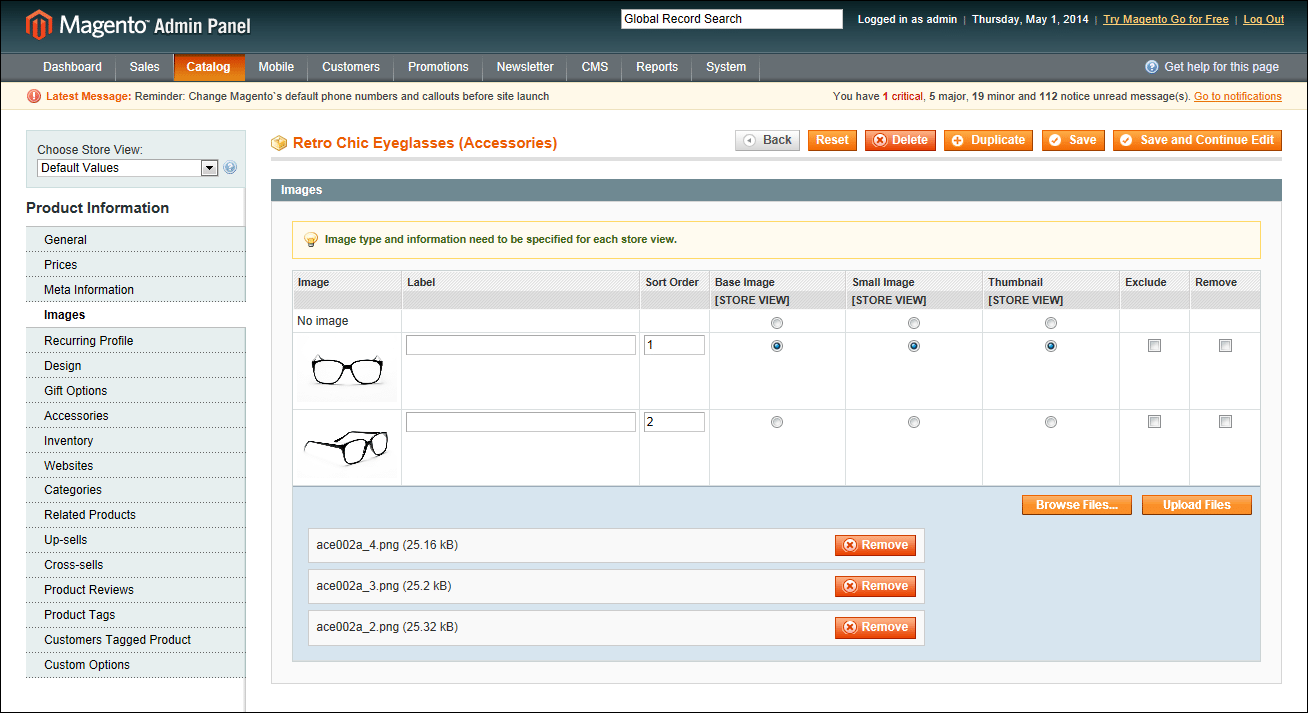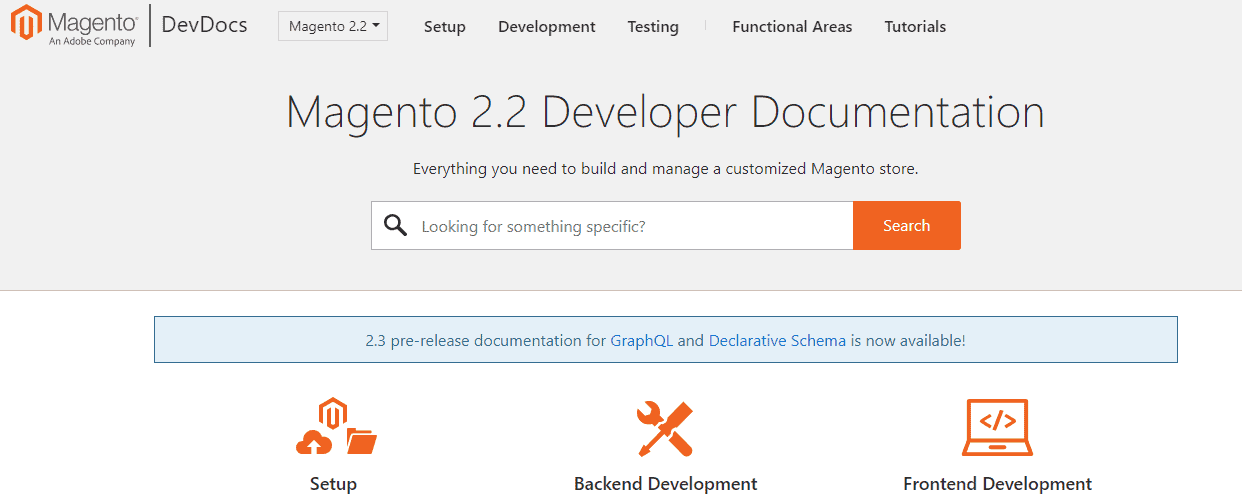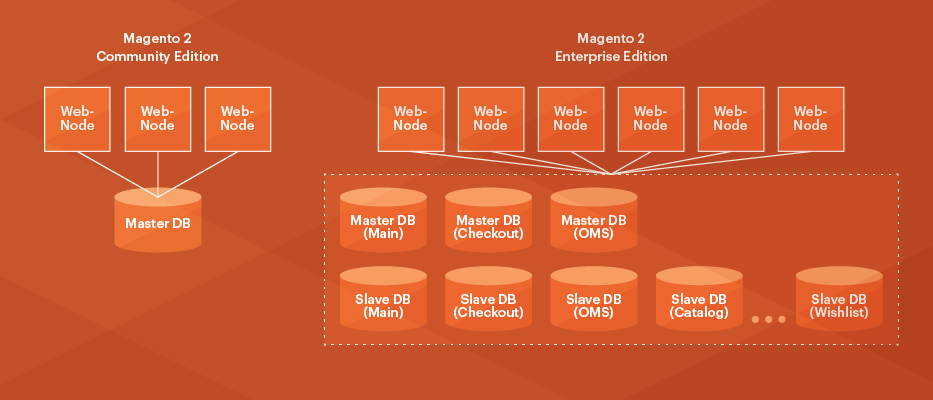Magento 2 – The Latest Version of Magento
The release of Magento 2 was always going to be a big deal. Its predecessor, Magento 1, faced stiff competition from increasingly popular platforms such as WooCommerce, Shopify, BigCommerce and Volusion, just to name a few. Sites created using Magento 1 were notoriously difficult to create and maintain, and would routinely present site owners with new challenges.
In 2016, Magento 2 was finally released with hopes that it would reinstate the platform as the go-to for enterprise and small-to-medium businesses (more on this later on). Reactions to Magento 2 have been mixed, to say the least, and in the 2 years that it has been available only 64,000 ecommerce sites have been using it. This isn’t bad by any means, but it also isn’t entirely convincing.
For users who’re deciding which ecommerce platform to use for their store, the sheer amount of choice can be inundating. What compounds this problem is that there are now several excellent ecommerce platforms available.
In this article we’ll be talking about the Magento 2 platform and whether it should be on the list of considerations for your ecommerce site.
Before we jump into Magento 2 however, it is important that we discuss why Magento as a platform got so popular.
Magento: An Overview
Magento vs the World
These days users can choose from several platforms to built their ecommerce site on. Popular choices include Shopify, BigCommerce, Wix and Squarespace (with Shopify being the most capable, in our opinion). All of these are very capable solutions no doubt, and they all have one thing in common: they’re SaaS products.

Being SaaS products, they’re very easy to set up and use – to the point where nearly anyone can use them to build a professional ecommerce store. They also happen to be very cost-effective when it comes to ecommerce. We recently published an article detailing the costs involved in WooCommerce store development, and those were in the region of around $700 / year even for the most barebones store. Hosted solutions like Shopify on the other hand, can cost as less as $290 / year. This makes it abundantly clear why hosted solutions are simply exploding in popularity.
Just Magento Problems
Magento, like WooCommerce, is a self-hosted ecommerce platform. That means that the store owner is responsible for its installation and deployment on a hosting server. What’s more, after it has been deployed it’s not exactly the easiest platform to work with.

It has a steep learning curve and requires a certain level of skill from developers. Getting comfortable with its concepts, terminology and quirks can take a long while and require serious investment on part of the developer. Compounding the problem is that Magento 1 has a woeful lack of documentation.
Because of this, Magento developers tend to be expensive, and prohibitively so. The costs involved in developing a Magento site can often surprise even the biggest companies, and this is where hosted solutions such as Shopify tend have a significant advantage. However, it’s not all bad news for Magento.
Magento’s Edge
Popular SaaS solutions such as Shopify and BigCommerce might offer an easier way to get your ecommerce store off the ground, but for complex ecommerce operations these platforms can pose severe limitations in terms of features and functionality. Magento on the other hand is open-source, which makes gives it the kind of extensibility that hosted platforms cannot hope to match.
With Magento, merchants can fine tune critical aspects of the system such as hosting, database usage, caching and so on. Also, with Magento the merchant is not at the mercy of support handled by a single organization. Merchants can research which agencies provide the best support and then choose to go with them. SaaS solutions are undoubtedly ahead when it comes to upfront costs and convenience, but as your business grows and the demand for complex features arises, their inherent limitations are immediately exposed.
While Magento is a difficult platform to work with, its modular structure and robust architecture have made it a favorite for enterprise operations where integrations with internal systems such as CMS and ERPs are an absolute necessity. It also has support for plugins, which coupled with its strong development community has led to the development of more than 3000 of these. It’s easily ahead of competitors when it comes to the number of plugins available.
To Install or Not to Install a Magento Plugin?
Magento’s strong plugin support might seem like a strong point at first but consider this: this is a platform that’s notoriously difficult to work with. As such, most plugins have been created by developers who’re simply not fully familiar with the deep intricacies of the platform. It’s quite normal for extensions to clash with each other, often wreaking havoc with the stability of the website.
The Need for Magento 2

Over 400,000 ecommerce sites are powered by Magento all over the world. While it’s certainly not lacking in popularity, it has seen stagnant growth over the past few years. Most of that can be attributed to the rising popularity of convenient SaaS ecommerce products. Moreover, Magento 1 isn’t exactly cutting edge either. Below we’ll discuss some of the factors which necessitated the development of Magento 2.
1. Terrible Documentation
Magento is hard enough for developers to get used to as it is, but it’s really the lack of proper documentation that makes it worse. Due to this, developers often had to undertake expensive and time-consuming training courses, debug problems themselves (which again takes a lot of time), coordinate with other Magento developers on forums and in some cases going so far as to reverse-engineer the platform in order to get a better grasp of it.
2. Performance Issues
Magento is a complex system and struggles to keep up with itself. In the past few years, Magento have worked hard to improve the platform, even if it meant refactoring entire subsystems. Optimizations like asynchronous indexing were introduced quite late and the all-important Full Page Cache support was limited to the $1800 / month Enterprise Edition. Merchants tried to get around this using so-called performance-enhancing plugins but they brought along problems of their own.
3. Complicated Scaling
Magento relies heavily on database calls, and that’s where one of the platform’s major bottlenecks lies. Magento 1 did not have native support for shared caching for a long while, nor was there any native support for splitting databases across multiple instances. This creates issues like poor scaling and if the database fails, the system will crash in case a fail-safe has not been deployed.
4. Poor User Experience

Magento’s user interface looks like something out of the 80s and is needlessly complex to understand and navigate. Doing something as simple as uploading images requires too many steps, resulting in a cumbersome user experience. This developers-only interface is one of the weakest aspects of Magento 1, and one of the reasons why it has been overtaken by beautifully-designed platforms such as Shopify and BigCommerce.
Magento 2 vs Magento 1 – The Improvements
The goal of Magento 2 was not just to overcome the shortcomings of its predecessor, but to attract a new audience demographic. A demographic that has so far been likely to use platforms like Shopify. In order to do so, the following are the improvements Magento 2 brings over Magento 1.
1. Extensive Documentation and Support Material
Magento 2 comes with comprehensive documentation, covering nearly all aspects of the platform, targeting front-end developers, backend developers, solutions specialists and Magento administrators.

The entire codebase of Magento 2 is now published and maintained on Github, providing much needed visibility into its code, as well as providing a convenient way to report and track bugs.
Magento Inc. has also launched free online courses for Magento 2 in a bid to attract more developers.
2. Better Performance and Scalability
Magento 2 brings with it one of the most surprising feature additions – Full Page Caching. This feature has a huge impact on the performance of the platform, and in a good way. What’s surprising about this addition is that Full Page Caching was offered only on Enterprise Edition of the original Magento (which costs $1800 / year).

MySQL (much to the ire of purists) is still the platform’s native querying language, but the way databases are handled has been significantly reworked. There’s now native support for data-splitting, which allows data to be split depending on which area of the application it is being used for. This allows for data to be kept on different servers, thus increasing the robustness of the system as a whole, as well as providing a much-needed performance boost.
Magento 2 also comes with out-of-the-box support for PHP7 and HHVM (both offering significant performance improvements for PHP code parsing).
3. Support for Modern Web Technologies
Magento 2 comes with support for modern web technologies like HTML5 and CSS. It also has a declarative templating system along with Model-View-View-Controller (MVVC) programming patterns.
4. Better Dashboard Designed for Non-Technical Users
The backend dashboard has been completely redesigned keeping in line with modern usability principles. It’s still not the most user-friendly dashboard in the world, but it’s a huge step forward from its predecessor’s stone-age ‘control center’.

With Magento 1, tasks as mundane as bulk-editing products required a call to the entire development team. Now however, the dashboard features an interface that has been designed keeping in mind non-developers. As such, there’s less need for merchants to have an inhouse developer at all times to do simple tasks such as adding new products.
Some other notable dashboard improvements include:
- Optimizations for a variety of screen sizes, which means the dashboard will render much better on mobile devices
- Better menu system
- Convenient product management
Having a user-friendly interface gives Magento a better chance of competing against popular enterprise ecommerce solutions such as Shopify Plus and BigCommerce Enterprise. Having an interface which is easy to get to grips with is important, as companies can choose to train less experienced resources to do repetitive tasks.
5. Native Support for Popular Payment Gateways

Magento 2 comes with Day 1 support for popular payment gateways such as:
- PayPal
- Braintree
- Authorize.net
- WorldPay (Enterprise Edition)
- CyberSource (Enterprise Edition)
Convenient checkout with popular payment gateways gives your store and customers a lot of flexibility. What’s more, development time is not wasted unnecessarily trying to integrate these common payment gateways.
Magento 2 Developer Challenges
While Magento 2 is a worthwhile upgrade over its predecessor, it does present its own unique challenges that developers must face. Below we’ll be listing some of the more glaring issues with the platform.
1. No Backwards Compatibility with Magento 1 Themes
Support for modern web technologies is definitely a win for Magento 2, but there’s also the issue of theme porting. Currently, there’s no way of transferring / porting your Magento 1 theme to Magento 2. There’s no other option but to build your Magento 1 theme for Magento 2 from scratch. Of course, you can save yourself a lot of time by buying a Magento 2 theme, but then your store will lose its familiarity in front of customers.
For merchants who’ll be creating a theme for their Magento 2 store from scratch, the good news is that the platform comes with a blank theme by default, which serves as a great canvas to build and customize.
2. No Backwards Compatibility with Magento 1 Extensions
Not all of the extensions that developers have come to appreciate on Magento 1 are available on Magento 2. This also poses a challenge for merchants who’re considering migrating as they’ll likely have to repurchase extensions and then hire resources to integrate them with the Magento 2 site.
This is a big deal, as Magento 1 plugins aren’t exactly cheap and repurchasing similar plugins for their Magento 2 site creates hesitancy for merchants. Also, not all Magento 1 extensions will be ported over to Magento 2. Developers are still getting accustomed to the Magento 2 platform and that means we’re still not at a point where the plugin marketplace for Magento 2 represents any kind of threat to thriving plugin ecosystems for competitors such as Shopify Plus.
3. Magento 2 Enterprise Edition Is More Expensive
If the cost of repurchasing plugins wasn’t enough, the fact that Magento 2 Enterprise Edition costs a whole $4000 more per year will certainly make merchants think twice before migrating from Magento 1.
With Magento 1, the subscription cost for the Enterprise Edition was somewhere around $18,000 per year. With Magento 2 Enterprise Edition, that figure jumps up to $22,000 per year. This increase in licensing fees is quite significant (almost 22%) and is enough for some merchants to simply stay with Magento 1.
Magento 2 Themes
Magento 2 is still catching up when it comes to third-party developer support and the number of themes available for the platform and its predecessor is a direct indicator of this.
For example, if you go to a popular theme marketplace such as Template Monster, you’ll find that there are 344 premium themes available for Magento 1, while just around 100 for Magento 2. And remember, Magento 2 isn’t just up against its older version, it’s up against fierce competition from Shopify, which has hundreds of high quality premium themes available.
Still, this isn’t to say that there are no good themes available for Magento 2 – quite the opposite is true in fact. In our rundown of the best Magento themes, we listed several Magento 2 themes that can be used for a variety of ecommerce niches.
Magento 2 Extensions
Magento’s open-source and extensible nature has always been one of its strongest points, because it has the platform has one of the largest selection of plugins in the market today. Compared to accomplished and popular platforms like Shopify, Magento still holds its ground quite respectably.

What’s surprising perhaps is the fact that Magento 2 – a platform that is just a couple of years old – has already surpassed its predecessor in the number of plugins offered. There are more than 2200 Magento 2 plugins available right now on the official Magento Marketplace.
Magento 2 Popularity – Has it Caught On?
Magento 2 was released to overcome the many shortcomings of its predecessor, so has it caught on? Has Magento 2 been successful in its adoption by non-developers? Well, the numbers paint an unconvincing story at the moment.
Data from Builtwith shows that there are currently just 34,000 Magento 2 stores live across the world. On the hand its predecessor – Magento 1 – is still going strong with more than 400,000 websites currently using it. This clearly shows that merchants using the older version of the platform have either:
- Invested so much that they can’t afford to migrate to Magento 2
- Or have found Magento 1 to perform within satisfactory levels
What’s more worrying though is that the Magento platform as a whole lacks greatly behind hosted ecommerce platform Shopify. Now this shouldn’t come as a surprise – Shopify is geared more towards smaller businesses while Magento users usually tend to be big organizations.
To give you an idea about how popular Magento (both 1.x.x and 2.x.x) is against its competitor, here’s an interesting graphic:

Interest in Shopify Plus – Magento 2’s direct competitor – has been unimpressive, at least according to this graphic that is. But interest in the Shopify platform as a whole is simply on another level.
Magento 2 Pricing
Magento 2 like its predecessor is an open-source ecommerce platform. As such, it is completely free to download and use – even with extensive modifications.
That’s if we’re talking about the Magento 2 Community Edition (CE), because there’s the Magento 2 Enterprise Edition which costs more around $22,000 / year. That’s certainly a lot of money for what’s basically a hosted version of an open-source software.
Yearly licensing fees for Magento 2 EE scale according to the customer’s gross sales revenue. As such, the more money your store makes, the more you pay for Magento 2 EE.
| Gross Sales Revenue | Magento 2 Enterprise Edition Pricing ($ / year) |
| Up to $1 million | $22,000 |
| $1 – $5 million | $32,000 |
| $5 – $10 million | $49,000 |
| $10 – $25 million | $75,000 |
| $25 – $50 million | $125,000 |
However, there are important differences that aim to justify the Enterprise Edition’s expensive licensing fee:
- Enhanced site management
- Enhanced catalog management
- Dynamic marketing and management features
- Customer loyalty programs
- Dedicated 24/7 support
For a full list of the Enterprise Edition’s exclusive features, check out this list.
Magento 2 Support
Magento 2 differs from its predecessor in one crucial way: it comes with comprehensive support documentation. This has made the lives of countless developers much easier, who would have otherwise sought answers to their problems on forums, Reddit or Stack Exchange.
However, that’s about as much support you can expect from the official Magento 2 team. To talk to a real person and discuss your issues, you’ll either have to take help from an ecommerce development agency or hire a Magento 2 developer.
We recommend that you enlist the services of a full-service digital agency who will take care of every aspect of your ecommerce store – be it development, marketing or advertising.
Should You Make the Switch to Magento 2?
For merchants using Magento 1
Reaching a decision of whether to upgrade your Magento 1 ecommerce site to Magento 2 or not is certainly a difficult one. Magento 2 brings a whole raft of improvements but it’s not without its own challenges.
To come to a properly informed decision, it’s best to consult with a digital agency that specializes in ecommerce. It would be especially helpful if you talked to an agency that has already done Magento-1-to-Magento-2 migrations as they’re in a better position to enlighten you about the unique challenges this process presents.
For merchants starting a new store
There are lots of great ecommerce platforms out there. If you’re looking to create a brand-new ecommerce store, it would be well worth your while going through reviews, features and the pros and cons of each of these platforms. Here at Logic Inbound, our default recommendation for small-to-medium businesses is to use Shopify.
If you want an enterprise-grade ecommerce platform which can be customized to the nth-degree, then Magento 2 certainly has a strong case. Here again, you might want to consult with an experienced ecommerce development agency as to whether the complexities of Magento 2 store development are worth the rewards. Remember, Shopify Plus and BigCommerce Enterprise are both strong alternatives here.
Closing Thoughts
Magento 2 is a powerful ecommerce platform that has been built from the ground up with just one purpose in mind: to be the best ecommerce platform there is. While it may not be able to compete with the likes of Shopify and WooCommerce when it comes to sheer popularity, its strong points including its modular design and robust architecture mean that it will always have its fair share of customers.
Compared to Magento 1, Magento 2 is hands-down the better ecommerce platform. It’s easier to use, has support for modern web technologies and comes with vastly improved support documentation. It’s a worthy successor and one that can certainly be used for full-blown enterprise ecommerce operations – provided you have the budget to afford it.
The post Magento 2 appeared first on Logic Inbound.
https://www.logicinbound.com/magento-2/
from WordPress https://logicinbound.wordpress.com/2018/08/21/magento-2/
No comments:
Post a Comment